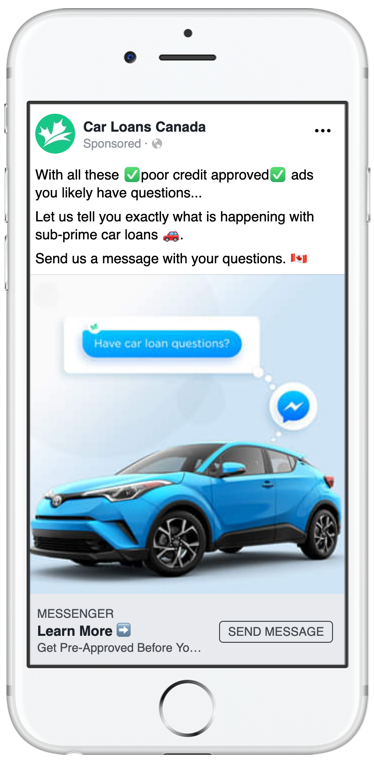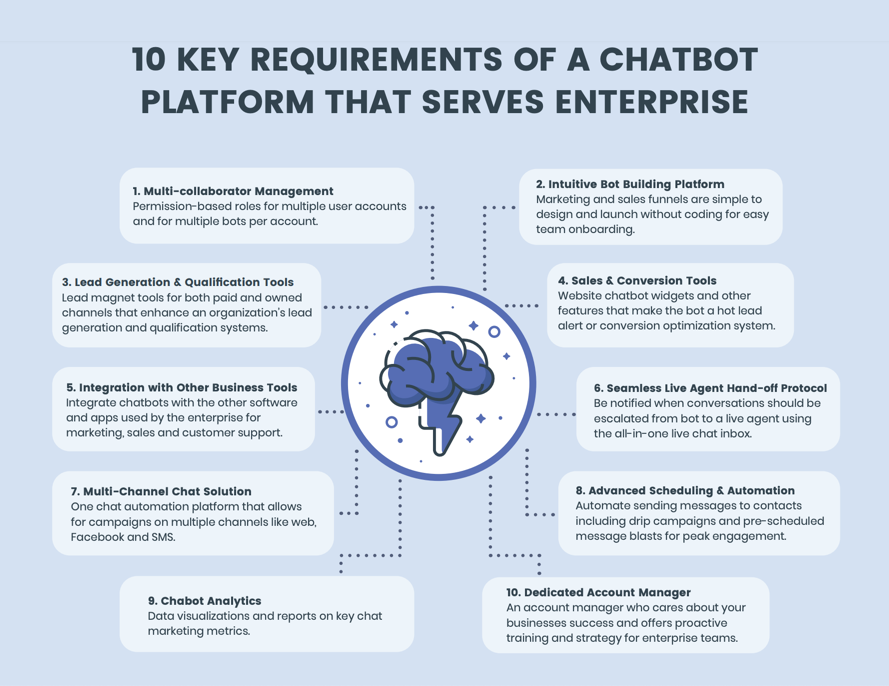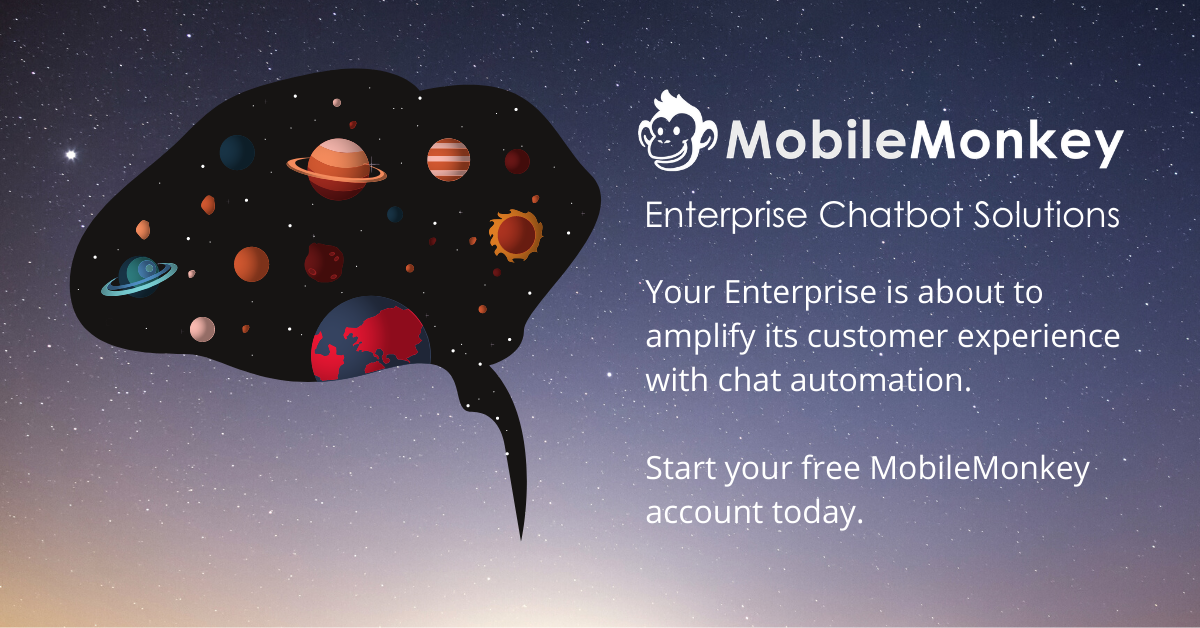Summary: Machine Learning (ML), Artificial Intelligence (AI), personalization & Natural Language Processing (NLP) are transforming the Customer Experience (CX). Organizations can use a 5-point framework to evaluate enterprise chatbot solutions based on critical factors from objectives to implementation.
In 2020, it’s predicted that 85% of customer interactions will be handled without human intervention (1). In 2022, businesses will collectively save $8 Billion by employing chat-based automation (2).
Today, nearly half of enterprise CMOs, chief strategy officers and senior marketers report that they are currently using automation in marketing, sales and customer service. Next year, that number is expected to jump to 80% of businesses using chatbots (3).
For many, enterprise chatbot solutions, or chat-based marketing automation is the next technology in line to scale efficiencies, reduce costs, and set up business success.
This article goes in-depth for marketers evaluating enterprise chatbot solution requirements and platforms for launching chat-based virtual assistants:
- What are enterprise chatbots?
- What is chatbot technology?
- Enterprise chatbot examples
- How can an organization evaluate chatbot development frameworks?
- Requirements of a GUI chatbot platform for enterprise
What Are Enterprise Chatbots?
Chatbots are software that interacts with end users in an interactive conversation in a chat interface.
Large-scale enterprise chatbot solutions typically require additional advanced capabilities:
- Intelligent handling of user requests personalized based on conversation history, past purchases, location, and context of the request.
- Monitoring user input and provide a seamless live agent takeover when requested.
- Integration with business systems and platforms, such as mobile app, marketing stack or security system.
- Multiple language handling.
Enterprise bots can be internal software for automating tasks including recruitment, hiring, or payroll.
However the majority of enterprise chatbot solutions involve customer-facing agents, performing roles from customer service to customer acquisition to engagement and virtual shopping assistants.
In 2017, Mindbrowser survey found that 95% of consumers feel customer experience is the major beneficiary of chatbots.
What Is Chatbot Technology?
In describing the current state of chatbot technology today, it is helpful to establish common terminology:
Artificial intelligence (AI): The idea that computer systems can be programmed to do things that require human intelligence, from visual and speech recognition to decision making.
Machine learning (ML): The ways that computer systems are trained to perform tasks by using patterns and inference instead of explicit direction. ML is a subset of AI.
Natural language processing (NLP): An area of computer science and AI development focused on how computer systems can understand and find patterns in human languages.
A primary question for a cross-department initiative involving IT, marketing, sales and customer service teams in early phases of implementing chatbot technology is:
How does a chatbot learn?
There are three major models of programming chatbots for business applications outlined in the 2019 Gartner research report “Competitive Landscape: Virtual Assistant Platforms, Worldwide“:
- Develop Machine Learning Algorithms (High Development Requirements & Management)
- “Use architectures emphasizing computational linguistics-based algorithms when multiple language support and small compute and storage footprints for edge deployment are required.”
- Leverage Existing AI Frameworks (Moderate Development Requirements & Management)
- “Leverage popular, affordable cloud services and artificial intelligence (AI) frameworks wherever cloud-first or cloud-only VA systems are required.”
- Program Functional Rule Systems (Least Development Requirements & Management)
- “Generate domain-specific rules, lexica and intents if their VA system requires swift time to market and clearly defined decision trees such as those found in more basic customer self-service applications or on interactive voice response (IVR) systems.”
The best-fit chatbot programming model depends on the organization’s development capabilities, program budget, and team collaboration requirements.
We recommend reviewing the decision-making framework to review the key questions for your evaluation of enterprise chatbot solutions.
Enterprise Chatbot Examples
There are a number of chatbots that provide real-world examples of what chatbots can accomplish for enterprises.
No matter the industry, use of chatbot automation can help a company provide great service while supporting fast customer care and lower costs.
Here are a few real-world enterprise chatbot examples that illustrate the power and game-changing nature of chat-based AI technology.
1. KLM Royal Dutch Airlines’s Customer Support Bot
BB Bot by KLM Royal Dutch Airlines (BB is short for Blue Bot, blue being the airline’s signature color), is a travel assistant chatbot that has significantly improved the enterprise’s customer service.
BB is capable of handling 13 different languages and in a given week will respond to 15,000 social conversations using those languages.
As an enterprise chatbot built to improve and simplify KLM Royal Dutch Airlines’ customer service, BB is doing its job with great success.
Beyond conversing and helping customers, this special enterprise chatbot utilizes Facebook’s checkbox plugin on the checkout page to allow customers to opt-in for booking confirmation, check-in notification, boarding pass, and flight status.
And it does all of this from within the Facebook Messenger application, used by 1.3 billion monthly users worldwide.
Chatbots improve the travel industry by providing personalized and user-friendly assistance on channels that are optimized for mobile users.
BB utilizes chatbots in its omnichannel strategy to boost accessibility for customers worldwide.
2. Verizon Wireless Customer Support Bot
Wireless phone and service provider Verizon Wireless utilizes a chatbot for customer service within its native mobile app.
The Verizon Wireless mobile app provides customers with a convenient mobile enterprise chatbot solution for actions including viewing account settings, account features, data usage and filing a claim for repair or insurance.
Source: Verizon Wireless
3. Car Loans Canada Auto Insurance Application Bot (Customer Acquisition)
Canada’s largest online automobile insurance provider Car Loans Canada automates lead generation and customer acquisition via connection to Facebook Ads.

Tests by the organization show a higher conversion rate and lower acquisition costs using a Customers.ai chatbot connected to Facebook ads, as detailed in the enterprise chatbot solution case study.
How Can an Organization Evaluate Chatbot Development Frameworks?
As with every new tech system integrated into a large-scale organization, there is an in-depth discovery process and requirements gathering phase for the enterprise business preparing to launch chatbot solutions.
Paul Gallovich, IT & network systems specialist, and principal chatbot developer at Chat-Intelligence, develops enterprise chatbots.
“Starting with questions like ‘who is the end user?’, ‘what is the role or objective of the automation?’ and ‘what teams will own and manage the system?’ — these are the questions that cross-departmental teams, from IT and engineering to CS and marketing, must navigate.”
Paul has taken part in designing and launching dozens of chatbot virtual assistants — from custom development, internal chat-based virtual assistant for colleges to public-facing chatbots intended to increase customer engagement and loyalty for multi-location food service chains.
So we asked him, what’s the best chatbot solution for enterprise?
“Every large-scale enterprise business has a different marketing stack, a different audience and interface requirements, and varying internal resources and expectations for chatbot management. It helps to apply a framework to derive what the right chatbot development or chatbot platform is best for a given organization.”
5-Point Evaluation for Chatbot Development
Customers.ai has helped hundreds of thousands of businesses determine the best chatbot development solution in light of resources and requirements.
How can an enterprise organization evaluate the appropriate fit and functionality of a chatbot platform for its firm?
The following 5 questions represent the essential discovery process for any enterprise preparing to implement chatbots.
- What is the business objective for the chatbot?
- What application will the chatbot function within?
- What business systems will be integrated with the chatbot?
- What team will design and run the chatbot?
- What teams require regular access to the back-end bot data and analytics?
Each consideration is detailed as follows.
1. What is the business objective for the chatbot?
This step involves identifying the chatbot use cases for each department within an organization.
Key decision makers and invested parties including directors, managers and employees may be interviewed for input.
The program lead will collect data needed to define the entities, intents and chatbot responses.
Chatbot business objectives include:
- Customer acquisition – marketing function
- Engagement & retention – marketing, sales and production function
- Customer experience – customer service function
- Internal systems automation (e.g., payroll, hiring) – often HR function
2. What application will the chatbot function within?
This step understands the objective of the chatbot and seeks to identify where the chatbot should interface with the end user.
The most common chatbot channels or entry points are:
- Website chat
- Web application
- Desktop application
- Mobile application
- Digital advertising platform
3. What business systems will be integrated with the chatbot?
The answer to this critical question is used to determine the capability of a chatbot platform to send and receive data obtained from the chatbot in connection with other systems used by the enterprise.
The most common integration requirements are:
- Digital ad platforms
- Ecommerce cart software
- Customer Relationship Management (CRM)
- Email marketing platform
- Website CMS
4. What team will design and run the chatbot?
Chatbot technology ranges in complexity and requirements dependent on an organization’s objectives.
Yet those objectives must inform the user interface of those managing the bot.
The enterprise must assess what teams will run day-to-day operations including content and response programming for the chatbot.
When non-technical teams such as marketing and sales managers are the organization’s intended users, a user-friendly graphical interface is required.
5. What teams require regular access to the back-end bot data and analytics?
Similarly, if an organization requires ongoing access to chatbot analytics and user data in order to assess effective implementation, successful enterprises adopt chatbot platforms with user-friendly, non-coding graphical user interfaces.

Paul Gallovich, enterprise bot builder and systems engineer, shared his process for information gathering at the outset of a new chatbot build.
Identify the chatbot use cases for each department within an organization.
- Interviewing directors, managers and employees
- Collecting data needed to define the entities, intents and chatbot responses.
Identify the business processes where chatbots could be used to automate and save time for each department.
- Interviewing directors, managers and employees.
- Collecting data needed to define the entities, Intents and chatbot responses.
Identify use cases for customer or client facing chatbots including touchpoints in the day to day operations. (These are all sources of data for building your AI chatbot.)
- Collecting data needed to define the entities, intents and chatbot responses related to the following.
- Customer service
- Customer acquisition
- Customer feedback
Develop the bot’s persona.
- Creating content that reflects the bots personality.
- Developing a consistent model for defining the following elements needed to train the machine learning model for the enterprise chatbot.
Train the bot to understand relevant material.
- Entities – Specific terminology the bot can recognize for that industry
- Responses – The bots responses.
- Context – Maintaining the conversation with the ability to answer follow up questions in the context of the conversation.
Create conversational context.
- Enterprise chatbots with AI need to be trained to have a conversation.
- Develop a continuity of context within the conversation when users, customers or clients ask the bot follow-up questions.
- Program the ability to respond to “small talk”. The bot must have the ability to handle random questions.
- Train the AI to understand general conversations as well as more specific questions.
- Depending on the complexity of the conversation, the chatbot needs to be developed with many types of contexts and have the appropriate responses.
10 Requirements of a GUI Chatbot Platform for Enterprise
Enterprise organizations utilize a complex technology stack to complete various tasks; this, plus the constant change and emergence of new tech and tools, leads to employees constantly having to switch between different apps and software.
Therefore, care and intention is required before new technologies are designated a good fit for the organization.
Customers.ai’s graphical interface chatbot platform has been specifically designed to eliminate the need for multiple apps and software, to integrate data with other business systems and to make more efficient key customer experience channels in a way that is usable by technical and non-technical staff.
Here are 10 key requirements an enterprise organization will need to evaluate a chatbot solution, which Customers.ai has been intentionally designed to solve.

1. Multi-collaborator Management
Large-scale organizations frequently have large teams that require access and various permissions for its chatbot development and management platform.
With Customers.ai, it’s far easier to collaborate with the people on your team, as well as control which team members have access to which tools.
If you need to restrict permissions for certain employees, it’s as simple as doing it right through the multi-bot, multi-user chatbot dashboard in Customers.ai.
In organizations with multiple bots, such as large agencies or multi-brand enterprises, Customers.ai also allows businesses to control which employees have access to or editing abilities for certain accounts.
In addition to collaborating within a team, agencies can collaborate with clients by inviting them to view and edit bots, eliminating the time-eater of back-and-forth email communication.
2. Intuitive Bot Building Platform
With Customers.ai, it’s easier than ever to create a chatbot for your enterprise. Just use the intuitive, visual chatbot builder.
All new tech comes with an onboarding and training period, but Customers.ai is the most comprehensive user-friendly chatbot application.
With this incredibly friendly bot creation platform, it takes as little as five minutes to create a chatbot to use for an enterprise.
3. Lead Generation & Lead Qualification Tools
Customers.ai chatbots are an incredibly easy way to generate and qualify leads.
There’s a number of ways that you can use Customers.ai for chatbot lead generation, and then collect lead information to build out detailed, personal user profiles.
Businesses can even create a bot to automatically qualify leads, eliminating time-consuming manual analysis for lead scoring and qualification.
This activity is implemented by creating a bot to ask lead-qualifying questions such as company info, budget, goals, and more.
4. Sales & Conversion Tools
Chatbots are utilized by ecommerce and retail enterprises to engage customers, drive leads and traffic, make sales and drive repeat customers.
Use Customers.ai chatbot conversion tools to create a chatbot that displays products and makes it as easy as clicking a button to make a purchase.
It’s also possible to create recommendation chatbots, which engage customers by using a guided question funnel that will lead users to the perfect product for them.
Chatbots simplify and optimize the shopping process for customers, helping ecommerce enterprises drive sales.
5. Multi-Channel Integration
Customers.ai integrates chatbots with a number of other commonly used tools for enterprise. Customers.ai also allows for implementation of chatbots on various platforms, including Facebook Messenger and webchat.
For example, use a chatbot with Facebook Ads so that you can drive users who come across ads to your chatbot instead of a website. This tactic has been proven to increase leads, increase conversions and decrease the cost of lead acquisition.
Install a chatbot on a website has been shown to increase conversions by 50% and higher.
Customers.ai also features a WordPress chatbot plugin for one-click installation of the chatbot on WordPress websites.
6. Seamless Live Agent Hand-off Protocol
Chatbots are great for automating time-consuming day-to-day tasks for your enterprise, but sometimes you need a live operator to speak with clients.
Customers.ai simplifies combining 24/7 chat automation with the personal touch of speaking to a human via Live Chat inbox within the enterprise chatbot solution.
Simply employ the Live Operator Takeover feature of Customers.ai and receive push notifications to let you know when it’s time for you to jump in via Facebook Messenger.
7. Audience Segmentation
Customers.ai is incredibly useful for enterprises with large audiences and client bases because it makes it easy to segment audiences based on customer interest and behavior.
You can decide on a number of different attributes to use to categorize your audiences into specific segments.
Chatbots excel at gathering additional user attributes such as emails, phone numbers, or interests to narrow audiences even more.
Once you have segmented audiences, those audiences can be nurtured, increasing conversions by providing them with relevant content.
Then, you can use these segmented audiences and attributes to remarket to qualified leads.
8. Advanced Scheduling & Automation Features
With Customers.ai, not only can you use chatbots to automate scheduling for your enterprise (i.e., appointments, etc.), but you can also schedule and program chat automation sequences for marketing.
Organizations can design automated campaigns for customer engagement and retention in a simple programmable interface.
Easily design chat blasts or chat drip campaigns to engage your audiences by creating the content, and scheduling it for a time in the week or via trigger in the customer journey that is likely to reach the most people.
Customers.ai’s campaign scheduling and automation features help enterprises achieve more while doing less.
9. Chabot Analytics
It’s important to gain insight into your marketing campaigns to see how well they are performing and find ways to improve.
Customers.ai offers chatbot analytics tools that display the efficacy of Messenger contact list growth and conversion campaigns from chat blasts, drip campaigns, Messenger Ads, and conversions in chat.
With Customers.ai’s chatbot analytics you can measure the performance of your chatbot campaigns, monitor your chat marketing growth, and understand how the chatbot contributes to these metrics.
10. Dedicated Account Manager
With Customers.ai Enterprise Solutions, businesses have access to a dedicated account manager.
Support for strategic and tactical decisions and implementation issues increases enterprise efficiency and success.
Getting Started with Chatbots for Enterprise
Begin your enterprise organization’s journey adopting chatbots for leads, sales and customer support with a one-on-one consultation to design your custom solution.
Create your free Customers.ai account to get started.

